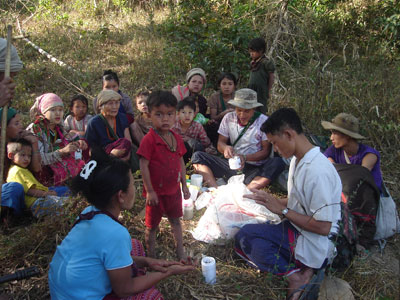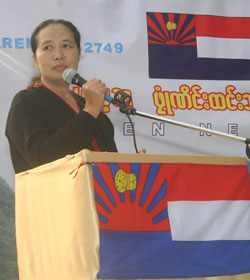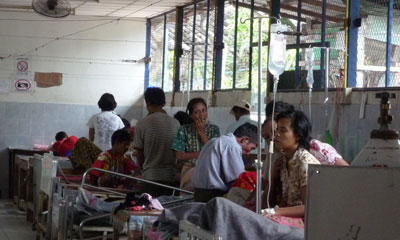Ma Yee Myint has been hospitalized for twelve days in the Mae Tao Clinic, in Mae Sot, Thailand, just 2 kilometers from the Burma border. However, she is happy to be there...
Ma Yee Myint has been hospitalized for twelve days in the Mae Tao Clinic, in Mae Sot, Thailand, just 2 kilometers from the Burma border. However, she is happy to be there.
 The thirty-two year-old flower seller from Mawlamyaing City, the capital of Mon State, in Burma, told BNI in a recent interview she is relieved to finally be receiving effective treatment for Low Blood Pressure. She said her blood pressure is slowly rising.
The thirty-two year-old flower seller from Mawlamyaing City, the capital of Mon State, in Burma, told BNI in a recent interview she is relieved to finally be receiving effective treatment for Low Blood Pressure. She said her blood pressure is slowly rising.
She said she has been ill, however, since August 2010, when she was so sick she could not work.
At that time she was treated in a local clinic for malaria. She said the medication made her sick.
A doctor at a hospital in Mawlamyaing told her she had no disease. After several visits to that hospital she travelled to a hospital in Yangon.
There she was forced to pay between 50,000 and 100,000 Kyat per day for treatment ($50-100 USD). That was more than her wages as a flower seller and her husband’s earnings as a taxi-driver could cope with.
However, there were still other costs.
“I had to pay money to (bribe) nurses. If I did not pay money to them (the nurses), they did not take care me very well. I even had to pay the cleaner who cleaned my bed 1,000 Kyat. Sometimes I was very angry at this situation.”
Ma Yee Myint is another example of a patient who failed to receive adequate health care for what are often treatable or preventable medical conditions inside Burma.
Mae Tao Clinic’s, Saw Lin Yon, estimated that half of the more than 71,000 patients treated last year were from inside Burma.
At the same time, a Karen woman (who asked not to be identified) has been waiting for several months in a Chiang Mai hospital to have bullet fragments removed from her leg, which have been there for nearly 15 years after she was shot by Burmese troops who attacked and burned her village in 1996. She could not have surgery then because she and her family were hiding in the jungle.
Now, she has to wait until her daughter recovers from recent surgery which corrected paralysis in her legs, because she is needed to help care for her daughter.
(Editor: For more about this woman and her daughter, see I AM ONLY HAPPY IN HALF MY HEART, in the BNI Feature section)
 The Burmese government’s policy of underfunding health services and rampant human rights violations, particularly against ethnic minorities, has caused many to become internally displaced persons (IDPs) inside their country, or refugees and illegal migrant workers fleeing to Thailand and other countries.
The Burmese government’s policy of underfunding health services and rampant human rights violations, particularly against ethnic minorities, has caused many to become internally displaced persons (IDPs) inside their country, or refugees and illegal migrant workers fleeing to Thailand and other countries.
Vit Suwanvanichkij, MD, of the Center for Public Health and Human Rights, Johns Hopkins Bloomberg School of Public Health, joined other health care workers and researchers in criticizing the Burmese government for its health policies and human rights record at a recent roundtable discussion at Chiang Mai University.
“I think one point I often make is that respect for human rights is good health policy,” he told BNI in a recent email.
“Where there are abrogations of human rights, including disinvestment in basic health services, particularly for women and children, abuses perpetuated with impunity against a population, censorship, and barriers to humanitarian assistance, these create conditions which are detrimental to public health- and often foster the spread of infectious diseases. Sadly, Burma is a textbook example of this, particularly in eastern Burma,” he said.
Dr. Cynthia Maung, head of the Mae Tao Clinic, where Ma Mee Myint is being treated, is also concerned about the health crisis in Burma, especially on its eastern border.
Dr. Cynthia, as she is affectionately known, is a Karen medical doctor who has lived in Mae Sot, since 1989.
She left Burma after the infamous 1988 Uprising, which resulted in thousands of Burmese citizens being slaughtered by the military. Since that time she has run the Mae Tao Clinic with a team of paramedics and teachers.
Tens of thousands of Burmese refugees, migrants and orphans receive health care not available in their homeland at the clinic.
“Especially in the eastern Burma, 30% of population has been suffering from human rights violations, including forced relocation and destruction of food supplies,” she said in a recent interview.
“In these areas, 60% of the children die from malaria, diarrhea, and respiratory diseases. These diseases can be treated and cured,” she said.
“The rate of malnutrition and child death is very high in the areas where human rights violations have happened; 40% of children suffer from malnutrition.”
The Back Pack Health Worker Team (BPHWT), chaired by Dr. Cynthia, trains and equips paramedic medical teams to deliver health care to IDPs inside eastern and western Burma. It released a report in 2006, entitled: CHRONIC EMERGENCY: Health and Human Rights in Eastern Burma, in which it is critical of the military government’s “long-term disinvestment in health (care)”.
The report said basic health care indicators collected in IDP areas of eastern Burma “bear more resemblance to other areas facing humanitarian disasters, such as Sierra Leone, Rwanda, the Democratic Republic of the Congo, or Angola, than those reported officially by the Burmese government to international organizations such as UNICEF.”
The BPHWT, in cooperation with the Burma Medical Association, National Health and Education Committee, health organizations serving the Kayin, Kayah, Mon, Shan and Palung communities, with assistance from the Center for Public Health and Human Rights, John Hopkins Bloomberg School of Public Health, produced an October 2010 report called DIAGNOSIS CRITICAL: Health and Human Rights in Eastern Burma.
The report said: “Burma only spends 1.8% of total government expenditures on health, leaving Burma in 138th position in the United Nations Development Program’s Human Development Report for 2009.”
In its conclusion, the report stated:
 “The ongoing widespread human rights abuses committed against ethnic civilians and the blockade of international humanitarian access to rural conflict affected areas of eastern Burma by the ruling State Peace and Development Council (SPDC), mean that premature death and disability, particularly as a result of treatable and preventable diseases like malaria, diarrhea, and respiratory infections, will continue.”
“The ongoing widespread human rights abuses committed against ethnic civilians and the blockade of international humanitarian access to rural conflict affected areas of eastern Burma by the ruling State Peace and Development Council (SPDC), mean that premature death and disability, particularly as a result of treatable and preventable diseases like malaria, diarrhea, and respiratory infections, will continue.”
To Dr. Suwanvanichkij, a workable solution lies in treatment of the underlying disease, rather than just the symptoms.
“For sustainable gains in public health to take place, these underlying contributors, which aid and abet the spread of diseases (including across internationally-recognized borders) must be addressed. "Simply" going out and giving out pills alone won't work- as a Karen medic friend once told me, "that is like giving paracetamol (Tylenol) for malaria." It makes the fever go down but without actual treatment for malaria, your patient will still die- albeit with a nicer fever curve,” he said.
“We highlight this kind of health crisis in Burma because we want the international community to investigate the human rights violations in Burma and to take action against the military government,” Dr. Cynthia said.
However, with so many members of the international community reluctant to interfere with the new government’s policies, as well as an escalation in armed conflict in eastern Burma compounding the regime’s continued disinvestment in health services and human rights abuses against ethnic minorities, the health crisis continues unabated.
“Like it or not, health is deeply political, and the biggest drivers of ill-health today often are rooted in misgovernance,” Dr. Suwanvanichkij said.
“Without acknowledging such, many of today's biggest epidemics, including malaria, TB, and HIV in Southeast Asia, are virtually guaranteed to continue to exact a heavy toll in the region- disproportionally affecting those who are often already marginalized by their governments.”



